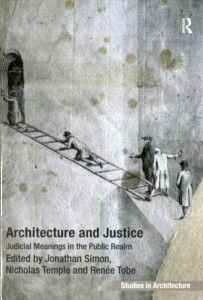 Simon and his co-editors explore the architecture related to the judicial system and the connection between justice and architecture to “examine the effects that architecture has on both the place of justice and on individual and collective experiences of judicial processes” (pg. 1). The book is organized to transition from individual, intimate stories, to more broad commentary.
Simon and his co-editors explore the architecture related to the judicial system and the connection between justice and architecture to “examine the effects that architecture has on both the place of justice and on individual and collective experiences of judicial processes” (pg. 1). The book is organized to transition from individual, intimate stories, to more broad commentary.
The first part discusses prisons and prison cells, including their design and the experience of living in prison. The authors note that the simple lines, the utilitarian austerity give prisons a contemporary feel. Prisons are naturally boxy places, due to the presence of square cells, and the architecture often reflects the seriousness of the place, adding to the sensation of being trapped. Next, the courthouse and courtroom are explored, including an essay on a “Virtual Court Pilot” in the United Kingdom, which would allow cases to be heard quickly and efficiently. Courtrooms, like prisons, are meant to convey a sense of seriousness, but without the austerity of prisons; instead they strive to also demonstrate the importance and morality of the judicial system. The two remaining parts of the book cover more general topics and explorations of justice and architecture, including articles on the spatial aspects of justice and the role of architects and justice in Athenian dramas. This section examines theoretical and big-picture subjects, ending the book on universal themes connecting architecture and justice.
Almost every city in the United States has a local courthouse or city hall, some place where civic duties take place. It is a place some people hope to never enter. Beautiful, imposing buildings that remind us of the laws we abide by. Or in the case of prisons, boxy, modern buildings that warn us against breaking the code. The architecture itself is meant to express the grandiosity of the justice system, creating an indelible if subtle connection between justice and the architecture representing it.
